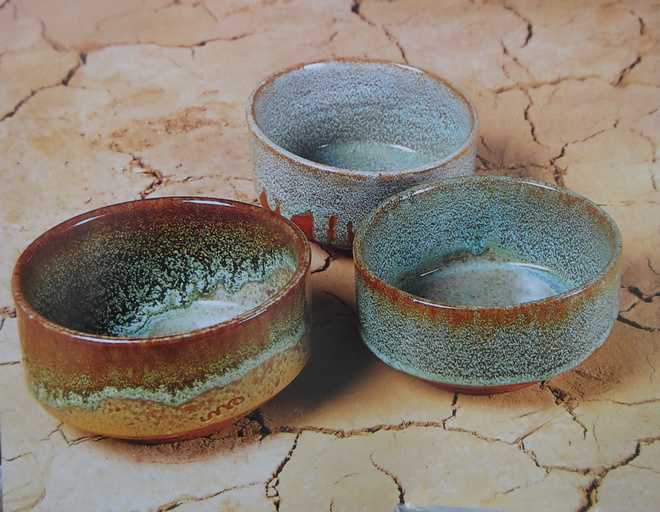
Set of bowls: the last pieces of pottery made by Gurcharan Singh.
BN Goswamy
The urge to create is part of the eternal in man. From early times he has been creating forms as an expression of his internal urge. For more than ten thousand years man has expressed his feelings and his aesthetics in clay.
….
Every once in a while I am in tune with clay, and I hear music. It is like poetry. Those are the moments that pottery is truly beautiful for me.
The feel of clay in your hands is something difficult to describe. It is a living thing. Even when a pot is complete it remains a part of you, an extension, as you hold it, or drink from it or eat from a plate. — Gurcharan Singh
Very early on, as one read Indian myths and began to dip into sacred texts, one came upon passages that related to Vishwakarma, the great architect and engineer, ‘divine fabricator of the world’. He had five sons or descendants, one learnt: takshaka, kumbhakara, sutradhara, suvarnakara and tamraka, which translated roughly into ‘carpenter’, ‘potter’, ‘weaver’, ‘goldsmith’, and ‘worker in copper’. The connection between them, and the references, was obvious: without these artisans, the basic needs of society could not have been fulfilled.
It all came up at a friend’s place where coffee was being served in the most elegantly fashioned of cups streaked with blue drip. Conversation turned, for a while, to the use of blue in pottery and some spoke of those superb jali-screens made up of rising arc-shaped, piling up, pieces of clay that adorn the India International Centre in Delhi. From those, it went on, almost inevitably, towards Sardar Gurcharan Singh, the gifted potter who was an agent of change, at least in India, as far as art pottery goes: founder of the famed Delhi Blue Art Pottery, who died just a quarter of a century ago.
Any account of Gurcharan Singh’s life makes for fascinating reading, a thoroughly absorbing mix of adventure, courage, vision, and utter dedication. Coming as he did from a family settled in Gujranwala, now in the Punjab that is in Pakistan, he was born at Srinagar where his parents then were. The year was 1896. In Kashmir Gurcharan Singh kept studying, concentrating on geology, in which he earned a bachelor’s degree, something that obviously came in handy when he turned later to ceramics. But, strangely, it was an encounter with an astrologer, it is said, that led to other things. The astrologer confidently predicted foreign travel for the young Sikh, something he could never even have dreamt of. But events did move in that direction.
Delhi, the new capital, was in the process of being built then and Gurcharan Singh took up work under a family friend, Sardar Ram Singh Kabuli, who had built up Delhi Potteries which supplied huge quantities of tiles, among other things, to the builders. Quickly, the relationship took another turn: the employer-friend not only gave his daughter in marriage to young Gurcharan Singh but also, recognising his talent and the fire in his belly, decided to send him for training to Japan — the home of all great pottery in Indian eyes — and that is where this enterprising young potter landed in 1919.
One gets the feeling that the young Sardar somehow must have decided that an unlikely opportunity having suddenly appeared, he was going not only to seek instruction in techniques but to set off in search of ‘the perfect form’, like so many great Japanese potters had done in the past. But it was not to come easy. Gurcharan Singh had no access either to Japanese culture or to Japanese language. Slowly, after having stayed with an Indian friend in Yokohama for a short while, he decided to move in with a Japanese family. Friendships blossomed; he got himself a tutor; became informal enough with that circle to give up the European clothing that he had donned when he arrived and to go back to Indian apparel which became a hit with many colleagues in the field to whom he had endeared himself with his warm and open manner. Travels to Tokyo followed; he moved into a colony of Japanese potters; became friends with the head of the Crafts Museum; held exhibitions of his work. In 1922, he returned to India, but not alone: with him were seven boxes of ceramics: Japanese, Korean and Chinese.
Back at home, he reached out to an old ‘teacher’ of his, a talented potter named Abdullah. The two — a Sikh and a Pathan — began working together. Much followed: Gurcharan Singh taught for a while at Ambala; founded the Delhi Blue Art Pottery; made friends across the borders, like with Bernard Leach, the renowned potter; held exhibitions of some of his seductive work in Bombay and Delhi. But the crowning work of his could be seen at the little, picturesque village of Andretta, in the Kangra valley, within touching distance of the great snow-covered Dhauladhar range. This is where he found the greatest fulfilment, for Andretta slowly turned into an artists’ colony. Norah Richards, pioneering theatreperson, had settled here; Prithvi Raj, the great actor, moved in from time to time; Professor Jaidev, Professor of English literature, came and built a house there; Sobha Singh, the famed painter, ran his studio. The little village had turned, one might say, a place of glazed surfaces and rough textures.
Even as, long after he has gone, one sits down to see the body of his vast range of work — all those vases and bowls, pitchers and coffee-sets, plates and tiles, one can see that there was more than beating and pugging, crushing and wedging, throwing and pinching, going on in Gurcharan Singh’s work. He was more than simply into terracotta and earthenware, vitreous ware and semi-porcelain. His was a search for soul in his work: discovering, imparting, reaching out for it.



























